After his exit from the Super Six tournie due to an eye injury, many wondered if Mikkel Kessler would ever be back. With his big win over Mehdi Bouadla, the Viking Warrior has not only started his comeback, but started it with style. At 32, Kessler still has at least a couple of good years left in him, so another run at a championship is all but certain. Since his short term options are clear to the schooled observer of boxing, they make for an interesting lesson in the logic of boxing as a business.
Kessler’s Appeal

The Super Middleweight Division’s Dance Partners
The WBC, IBF and WBA belts are currently held by Carl Froch, Lucian Bute and Andre Ward respectively. Since Froch and Ward are squaring off in the Super Six Finals, and Bute is waiting for a lucrative bout with the winner of that contest, none of these fighters is available for a clash with Kessler in the near future. Win or lose, I imagine Carl Froch would love a rematch with Kessler, and Froch would bring with him a hefty UK audience. However, the timing dictates that such a fight could not take place until sometime in 2012.
A fight with the WBA’s “Regular” Champion, Dimitri Sartison, holds little appeal for Kessler. A win there merely makes Kessler the de facto #1 challenger for Ward, and he doesn’t really need a fake black strap around his waist to get that fight. WBO Champion Robert Steiglitz seems to be that type of European fighter who, after grabbing a title, carefully avoids a clash with anyone who might pose even the slightest challenge. So, while Steiglitz is the quickest, easiest path back to a belt, Kessler will have a very hard time getting the German into the ring with him.
So who does that leave? Glen Johnson and Andre Dirrell would be big fights only on paper without the backing of a major cable network, probably Showtime, and Showtime has its hands full with the Super Six and then Bute vs. the winner of the Super Six. Without cable backing, neither fighter brings the necessary financial punch to the table necessary to justify a risky, high profile title fight. The same applies to the host of fringe contenders out there, ranging from Allan Green to Librado Andrade to Eric Lucas.. None of these men brings a big following to the ring with them, so Kessler would make just as much money fighting a journeyman in Denmark as fighting any one of them in Atlantic City.
The only real potential for a big fight this year is Arthur Abraham, who has a following just south of the border in Germany. The problem is that Abraham has serious wounds to lick after being decisively thumped by both Andre Dirrell and Carl Froch. I doubt his management will be eager to put “King” Arthur into the ring with a man with the boxing skills of the Viking Warrior, at least not without a string of tune ups first.
What Next?
Based on all these facts, I don’t see any big fights for Mikkel Kessler for at least a year. He can make good money fighting lesser opponents in Denmark, and anyone who could fatten his purse enough to justify doing otherwise is either tied up or damaged goods. In a year, Abraham might have his moxie back or Froch might be cruising for a rematch, but until then Kessler will be biding his time.











